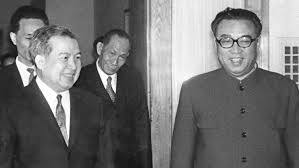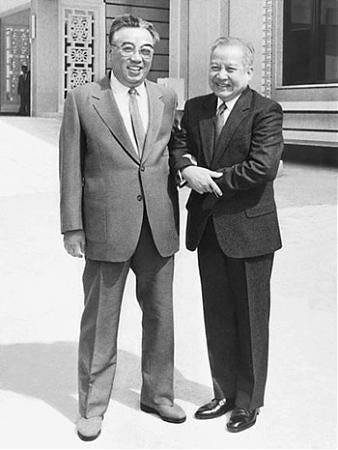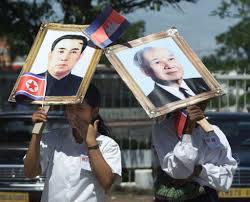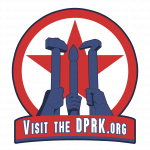The relationship between North Korea and the Khmer Rouge regime in Cambodia—officially Democratic Kampuchea—is a fascinating yet often overlooked chapter in Cold War history.
While the Khmer Rouge is globally infamous for its brutal reign under Pol Pot, North Korea’s ties with Cambodia during this period reveal a more nuanced and strategic connection, shaped largely by personal relationships, regional geopolitics, and ideological affinity.
The Foundations: Kim Il Sung and Prince Norodom Sihanouk
The roots of the North Korea-Khmer Rouge relationship lie deeper than just the infamous Pol Pot era. A critical factor was the close personal and political ties between Kim Il Sung, the founding leader of the DPRK, and Prince Norodom Sihanouk, Cambodia’s monarch and a towering figure in Southeast Asian politics.
Kim Il Sung and Sihanouk shared a rapport built on mutual respect and a common vision of anti-imperialism and national sovereignty. Sihanouk had long resisted Western colonial influence and American intervention in Cambodia, which aligned with Kim’s narrative of resisting imperialism in Asia. Throughout the 1960s and early 1970s, Sihanouk enjoyed friendly relations with Pyongyang, visiting North Korea multiple times and receiving military and diplomatic support.
This relationship was so significant that North Korea hosted Sihanouk in exile after the 1970 coup that deposed him. During this period, Pyongyang became a safe haven for the prince, further solidifying ties between the two countries.

North Korea’s Preference for Sihanouk Over Pol Pot
While the Khmer Rouge under Pol Pot seized control in 1975 and established Democratic Kampuchea, North Korea’s leadership maintained a nuanced stance towards the regime. Though both North Korea and Democratic Kampuchea shared a broadly anti-imperialist and socialist rhetoric, DPRK’s deeper political and ideological sympathy was more aligned with Sihanouk than with Pol Pot’s radical and often erratic policies.
Sihanouk’s vision for Cambodia was rooted in national independence and moderate socialism, more palatable to North Korea’s carefully crafted diplomatic posture. Pol Pot’s regime, characterized by extreme Maoist policies and mass atrocities, was treated with cautious distance. However, the DPRK officially recognized Democratic Kampuchea, maintained diplomatic relations, and even hosted the Cambodian embassy in Pyongyang.

DPRK-Democratic Kampuchea Diplomatic and Military Relations
Despite the complex dynamics, North Korea and Democratic Kampuchea shared formal diplomatic relations. The DPRK was among the few countries to maintain an embassy in Phnom Penh after 1975, demonstrating a commitment to engaging with the regime on official terms.
Beyond diplomacy, North Korea reportedly provided military training and technical assistance to Democratic Kampuchea. Although the extent and nature of this support remain somewhat opaque due to the secretive nature of both regimes, testimonies from defectors and scholars suggest that North Korean advisors were involved in military and political training of Khmer Rouge cadres.
This military cooperation was part of North Korea’s broader strategy to support socialist and anti-imperialist movements across Asia, particularly those that opposed Western influence and aligned with Pyongyang’s vision of regional solidarity.
Ideological Sympathies and Differences
Both the DPRK and Democratic Kampuchea professed socialist ideologies, but their approaches diverged significantly. North Korea under Kim Il Sung developed the Juche ideology—a blend of Marxism-Leninism adapted to Korean nationalism and self-reliance—focusing on strong centralized control and a stable, enduring state structure.
In contrast, the Khmer Rouge pursued an aggressive form of agrarian communism inspired by radical Maoism, marked by extreme social engineering, purges, and the attempt to eliminate all perceived “enemies” of the revolution.
This ideological difference meant that, while officially allied, the DPRK kept a careful distance from some of the Khmer Rouge’s excesses. Pyongyang’s support was framed more in terms of regional anti-imperialist solidarity than wholehearted endorsement of Pol Pot’s brutal policies.
The Fallout and Legacy
The fall of Democratic Kampuchea in 1979, following the Vietnamese invasion that toppled Pol Pot’s regime, led to shifts in regional alliances. North Korea, like many other socialist countries, maintained diplomatic recognition of the Khmer Rouge’s government-in-exile for years after their ousting, in part due to geopolitical opposition to Vietnam’s occupation of Cambodia and the influence of the Soviet Union. Ironically this had North Korea aligned with the imperialist rather than the progressive block with regards to Cambodia.
North Korea’s continued engagement with the Khmer Rouge faction reflects the complicated realities of Cold War-era diplomacy, where ideology, geopolitics, and regional rivalries often overshadowed human rights concerns.
Today, North Korea’s historical relationship with Cambodia is often overshadowed by other geopolitical narratives. Yet the ties with Sihanouk and Democratic Kampuchea illustrate the DPRK’s consistent strategy of supporting anti-imperialist regimes and leaders aligned with its vision of resistance to Western dominance.

Conclusion
The story of North Korea and the Khmer Rouge highlights a rarely explored dimension of Cold War history in Southeast Asia. At its core, the relationship was shaped by the enduring bond between Kim Il Sung and Prince Norodom Sihanouk, which influenced DPRK policy more than mere ideological alignment with Pol Pot’s violent regime.
North Korea’s diplomatic and military support for Democratic Kampuchea fits within its broader pattern of fostering ties with states and movements opposing Western imperialism. Although the Khmer Rouge’s radicalism presented challenges, Pyongyang navigated this relationship with a blend of ideological solidarity and pragmatic diplomacy.
For those studying the complex history of the region, the DPRK-Khmer Rouge connection offers a window into the geopolitical chessboard of the Cold War and the enduring legacies that shape relations in East and Southeast Asia today.
